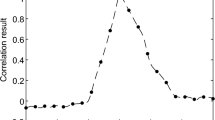Abstract
Failure to maintain a safe driving distance between moving vehicles is one of the major causes of traffic accidents. Research on maintaining a safe distance with autonomous vehicles is especially important. This paper uses the Hilbert-Huang transform (HHT) method and error estimation to analyze the frequency modulated continuous wave (FCMW) signal of Doppler radar for autonomous vehicle applications. The FMCW signal is decomposed into intrinsic mode functions (IMF) using the empirical mode decomposition (EMD) method. The Doppler radar signal is then reproduced through the Hilbert spectrum obtained using the instantaneous amplitude and instantaneous frequency. The characteristics of the motion of the object are obtained by analyzing the reconstructed Doppler radar signal. The simulation and verification results confirm that this method can accurately estimate the distance between vehicles within the range of 20 ∼ 120 meters at speeds of 50 ∼ 230 km/h. Error estimation is also obtained based on the distance to the car in front and the vehicle’s speed. This study contributes by the application of the proposed Hilbert-Huang transform (HHT) method for the analysis of the frequency modulated continuous wave (FCMW) signal of Doppler radars. The method of this study has been applied to multi-target detection. In this simulation, there are 5 targets, each with a different distance from the car and the speed of the car. The simulation results show that the proposed method can improve the accuracy of the sensor in terms of estimating the distance, reliability and stability of the vehicle, and can increase the safety of the autonomous vehicles.
Similar content being viewed by others
References
Bi, X. and Du, J. S. (2010). A new waveform for range-velocity decoupling in automotive radar. 2nd Int. Conf. Signal Processing Systems (ICSPS), Dalian, China.
Bimbraw, K. (2015). Autonomous cars: Past, present and future a review of the developments in the last century, the present scenario and the expected future of autonomous vehicle technology. 12th Int. Conf. Informatics in Control, Automation and Robotics (ICINCO), Colmar, France.
Biswas, S., Tatchikou, R. and Dion, F. (2006). Vehicle-to-vehicle wireless communication protocols for enhancing highway traffic safety. IEEE Communications Magazine 44, 1, 74–82.
Campolo, C., Molinaro, A., Iera, A. and Menichella, F. (2017). 5G network slicing for vehicle-to-everything services. IEEE Wireless Communications 24, 6, 38–45.
Huang, N. E. and Shen, S. S. (2005). The Hilbert-Huang Transform and Its Applications. World Scientific Publishing. Singapore.
Huang, N. E., Hu, K., Yang, A. C., Chang, H. C., Jia, D., Liang, W. K., Yeh, J. R., Kao, C. L., Juan, C. H., Peng, C. K., Meijer, J. H., Wang, Y. H., Long, S. R. and Wu, Z. (2016). On Holo-Hilbert spectral analysis: A full informational spectral representation for nonlinear and non-stationary data. Philosophical Trans. Royal Society A: Mathematical, Physical and Engineering Sciences 374, 2065, 20150206.
Huang, N. E., Shen, Z. and Long, S. R. (1999). A new view of nonlinear water waves: The Hilbert spectrum. Annual Review of Fluid Mechanics, 31, 417–457.
Huang, N. E., Shen, Z., Long, S. R., Wu, M. C., Shih, H. H., Zheng, Q., Yen, N. C., Tung, C. C. and Liu, H. H. (1998). The empirical mode decomposition and the Hilbert spectrum for nonlinear and non-stationary time series analysis. Proc. Royal Society of London. Series A: Mathematical, Physical and Engineering Sciences 454, 1971, 903–995.
Kärnfelt, C., Péden, A., Bazzi, A., Shhadé, G. E. H., Abbas, M. and Chonavel, T. (2009). 77 GHz ACC radar simulation platform. 9th Int. Conf. Intelligent Transport Systems Telecommunications (ITST), Lille, France.
Li, J., Che, W., Shen, T., Feng, W., Li, X. and Deng, K. (2016). An improved waveform for multi-target detection in FMCW vehicle radar. 7th Int. Conf. Mechatronics, Control and Materials (ICMCM), Changsha, China.
Lin Jr, J., Li, Y. P., Hsu, W. C. and Lee, T. S. (2016). Design of an FMCW radar baseband signal processing system for automotive application. SpringerPlus 5, 1, 1–16.
Molina-Masegosa, R. and Gozalvez, J. (2017). LTE-V for sidelink 5G V2X vehicular communications: A new 5G technology for short-range vehicle-to-everything communications. IEEE Vehicular Technology Magazine 11, 4, 30–39.
Rohling, H. and Meinecke, M. M. (2001). Waveform design principles for automotive radar systems. CIE Int. Conf. Radar Proc. (CAT No.01TH8559), Beijing, China.
Zhang, D., Kurata, M. and Inaba, T. (2013). FMCW radar for small displacement detection of vital signal using projection matrix method. Int. J. Antennas and Propagation, 2013, 571986.
Acknowledgements
The authors would like to thank the ministry of science and technology, Taiwan, for financially supporting this research grant No.MOST109-2222-E-018-001-MY2.
Author information
Authors and Affiliations
Corresponding author
Additional information
Publisher’s Note
Springer Nature remains neutral with regard to jurisdictional claims in published maps and institutional affiliations.
Rights and permissions
About this article
Cite this article
Hsu, WT., Lin, SL. Using FMCW in Autonomous Cars to Accurately Estimate the Distance of the Preceding Vehicle. Int.J Automot. Technol. 23, 1755–1762 (2022). https://doi.org/10.1007/s12239-022-0153-4
Received:
Revised:
Accepted:
Published:
Issue Date:
DOI: https://doi.org/10.1007/s12239-022-0153-4




